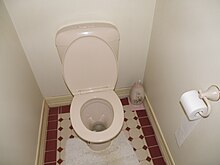Toilet (room)
**Terminology and Evolution of Toilets:**
– The term “toilet” originally referred to personal grooming but evolved to euphemistically refer to private rooms for urination and defecation.
– Variations in terminology include “lavatory” in the 19th century and “bathroom” in American English.
– “Water closet,” “loo,” and “lavatory” are some alternate terms used for toilets.
– Historical development of toilets includes the transition from open defecation to indoor toilets, with ancient Greeks and Romans having public toilets.
**Components of a Toilet Room:**
– The main item in a toilet room is the sanitation fixture.
– Other items may include a plunger, wall mirror, cupboard, sink with soap for handwashing, and a medicine cabinet for grooming.
– Methods of anal cleansing vary among different cultures and regions.
– Some toilets, like Japanese toilets, have unique features such as built-in sinks.
**Society, Culture, and Toilets:**
– All terms for toilets were originally euphemisms, and using direct terms was considered offensive.
– Broadcast censorship often banned certain terms related to toilets.
– Some countries have separate toilets for hygiene and privacy reasons.
– Japanese toilets are known for their advanced features, like built-in sinks.
**Historical and Architectural Influence:**
– The historical development of toilets is traced through various sources like Campbell, Lyle (2006) and Muthesius, Hermann (1904).
– Architectural influences on toilets are seen in suburban developments like Semi-Detached London and the work of architects like Edward W Godwin.
– The Edwardian House and houses in Britain from 1880-1914 reflect the evolution of toilets within architectural design.
**Global Perspectives and Cultural Significance:**
– Variances in toilet terminology and design are discussed in global contexts like Stack Exchange discussions and books like “An Uncommon History of Common Things.”
– Cultural significance of toilets is explored through works like “Culture Shock!: France” and “The English House,” reflecting differences in toilet practices and perceptions across regions.
– The impact of toilets on architecture and society is evident in the architectural influences of Muthesius, Hermann and societal developments like the Bedford Park Society.
A toilet is a small room used for privately accessing the sanitation fixture (toilet) for urination and defecation. Toilet rooms often include a sink (basin) with soap/handwash for handwashing, as this is important for personal hygiene. These rooms are typically referred to in North America as half-bathrooms (half-baths; half of a whole or full-bathroom) in a private residence.

This room is commonly known as a "bathroom" in American English, a lavatory or loo in the United Kingdom, a "washroom" in Canadian English, and by many other names across the English-speaking world.
